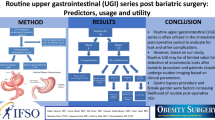Abstract
Background
There are no guidelines on the routine or selective use of contrast upper gastrointestinal series (UGI) after omental patch repair (OPR) of a gastric (GP) or duodenal perforation (DP). This study aims to elucidate whether the use of selective versus routine contrast study will lead to worse clinical outcomes.
Methods
A retrospective analysis of 115 (n = 115) patients with OPR of GP or DP was performed. Data were obtained from seven Florida Hospital campuses. Patients aged 18 and older from 2006 to 2016 were identified by ICD9 billing information. Patients were divided into two groups: UGI and no UGI. The UGI group was subdivided into selective versus routine. A selective UGI was defined as one or more of the following after post-operative day 3: WBC >12,000, peritonitis, fever >100.4 F, tachycardia >110 bpm on three or more assessments, and any UGI performed after POD 7. Perioperative symptoms, perforation location, size, abdominal contamination, laparoscopic or open, leak detection, length of stay, mortality, and reoperation within 2 weeks were also examined.
Results
No differences between the UGI group and non-UGI group relating to preoperative symptoms, leak detection, death, and reoperation rate were revealed. Differences in length of stay were found to be statistically significant with the UGI group and non-UGI at a median of 15.5 and 8 days, respectively. In the UGI subgroup, 20 of the 29 patients received selective studies. There were no statistical differences identified in leak detection, death, and reoperation.
Conclusions
Rates of leak detection, reoperation, and death in patients with GP or DP repaired with omental patch utilizing an UGI study were not statistically significant. An increased length of stay was observed within the UGI group. There was no advantage demonstrated between a selective versus routine UGI; therefore, the use of selective UGI should be based upon clinical indications.
Similar content being viewed by others
References
Bertleff MJOE, Lange JF (2010) Perforated peptic ulcer disease: a review of history and treatment. Dig Surg 27:161–169
Matoba Y, Katayama H, Ohami HJ (1996) Evaluation of omental implantation for perforated gastric ulcer therapy: findings in a rat model. J Gastroenterol 31(6):777–784
Chung KT, Shelat VG (2017) Perforated peptic ulcer—an update. World J Gastrointest Surg 9(1):1–12
Donovan AJ, Berne TV, Donovan JA (1998) Perforated duodenal ulcer: an alternative therapeutic plan. Arch Surg 133(11):1166–1171
Schiesser M, Guber J, Wildi S, Guber I, Weber M, Muller MK (2011) Utility of routine versus selective upper gastrointestinal series to detect anastomotic leaks after laparoscopic gastric bypass. Obes Surg 21(8):1238–1242
Madan AK, Stoecklein HH, Ternovits CA, Tichansky DS, Phillips JC (2007) Predictive value of upper gastrointestinal studies versus clinical signs for gastrointestinal leaks after laparoscopic gastric bypass. Surg Endosc 21(2):194–196
Carter JT, Tafreshian S, Campos GM et al (2007) Routine upper GI series after gastric bypass does not reliably identify anastomotic leaks or predict stricture formation. Surg Endosc 21(12):2172–2177
Doraiswamy A, Rasmussen JJ, Pierce J, Fuller W, Ali MR (2007) The utility of routine postoperative upper GI series following laparoscopic gastric bypass. Surg Endosc 21(12):2159–2162
Leslie DB, Dorman RB, Anderson J, Serrot FJ, Kellogg TA, Buchwald H, Sampson BK, Slusarek BM, Ikramuddin S (2012) Routine upper gastrointestinal imaging is superior to clinical signs for detecting gastrojejunal leak after laparoscopic Roux-en-Y gastric bypass. J Am Coll Surg 214(2):208–213
B JR, Simon TE, Jacob RK, Husain F, Choi Y (2012) Upper gastrointestinal swallow study following bariatric surgery: institutional review and review of the literature. Obes Surg 22(7):1039–1043
Schiesser M, Guber J, Wildi S, Guber I, Weber M, Muller MK (2010) Utility of routine versus selective upper gastrointestinal series to detect anastomotic leaks after laparoscopic gastric bypass. Obes Surg 21(8):1238–1242
Rawlins L, Penn R, Schirmer B, Hallowell P (2015) Accuracy of routine postoperative swallow study in predicting leak or obstruction after gastric bypass. Surg Obes Relat Dis 11(1):1–4
Hauck K, Zhao X (2011) How dangerous is a day in hospital? A model of adverse events and length of stay for medical inpatients. Med Care 12:1068–1075
Funding
No funding was obtained for this manuscript.
Author information
Authors and Affiliations
Corresponding author
Ethics declarations
Disclosures
Stephenie Poris, Andrew. Fontaine, Julie Glener, Stacey Kubovec, Paula Veldhuis, Yuan Du, Julie Pepe, and Steve Eubanks have no conflicts of interest or financial ties to disclose.
Rights and permissions
About this article
Cite this article
Poris, S., Fontaine, A., Glener, J. et al. Routine versus selective upper gastrointestinal contrast series after omental patch repair for gastric or duodenal perforation. Surg Endosc 32, 400–404 (2018). https://doi.org/10.1007/s00464-017-5695-6
Received:
Accepted:
Published:
Issue Date:
DOI: https://doi.org/10.1007/s00464-017-5695-6




